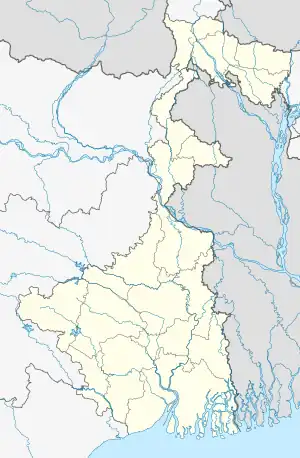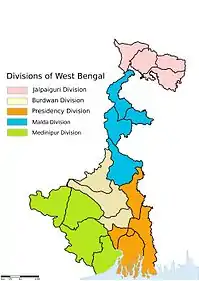Basudebpur
Basudebpur is a census town in the Samserganj CD block in the Jangipur subdivision of the Murshidabad district in the state of West Bengal, India.
Basudebpur | |
|---|---|
Census Town | |
 Basudebpur Location in West Bengal, India  Basudebpur Basudebpur (India) | |
| Coordinates: 24.6341°N 87.9817°E | |
| Country | |
| State | West Bengal |
| District | Murshidabad |
| Area | |
| • Total | 1.9975 km2 (0.7712 sq mi) |
| Population (2011) | |
| • Total | 12,599 |
| • Density | 6,300/km2 (16,000/sq mi) |
| Languages | |
| • Official | Bengali, English |
| Time zone | UTC+5:30 (IST) |
| PIN | 742187 |
| Telephone/STD code | 03485 |
| Vehicle registration | WB |
| Lok Sabha constituency | Maldaha Dakshin |
| Vidhan Sabha constituency | Samserganj |
| Website | murshidbad |
Geography
M: municipal town, CT: census town, R: rural/ urban centre, F: Facility
Abbreviation- TPS: Thermal Power Station
Owing to space constraints in the small map, the actual locations in a larger map may vary slightly
Location
Basudebpur is located at 24.6341°N 87.9817°E.
According to the map of Samserganj CD block in the District Census Handbook, Murshidabad, Anup Nagar, Jafrabad, Kankuria, Kohetpur, Jaykrishnapur, Uttar Mahammadpur, Chachanda, Basudebpur and Dhusaripara form a series of census towns from Dhuliyan, a municipal town.[1]
Area overview
Jangipur subdivision is crowded with 52 census towns and as such it had to be presented in two location maps. One of the maps can be seen alongside. The subdivision is located in the Rarh region that is spread over from adjoining Santhal Pargana division of Jharkhand. The land is slightly higher in altitude than the surrounding plains and is gently undulating.[2][3] The river Ganges, along with its distributaries, is prominent in both the maps. At the head of the subdivision is the 2,245 m long Farakka Barrage, one of the largest projects of its kind in the country.[4] Murshidabad district shares with Bangladesh a porous international border which is notoriously crime prone (partly shown in this map).[5] The subdivision has two large power plants - the 2,100 MW Farakka Super Thermal Power Station and the 1,600 MW Sagardighi Thermal Power Station.[6][7] According to a 2016 report, there are around 1,000,000 (1 million/ ten lakh) workers engaged in the beedi industry in Jangipur subdivision. 90% are home-based and 70% of the home-based workers are women.[8][9][10] As of 2013, an estimated 2.4 million people reside along the banks of the Ganges alone in Murshidabad district. Severe erosion occurs along the banks.[11]
Note: The two maps present some of the notable locations in the subdivision. All places marked in the maps are linked in the larger full screen maps.
Demographics
According to the 2011 Census of India, Basudebpur had a total population of 6,830, of which 3,497 (51%) were males and 3,333 (49%) were females. Population in the age range 0–6 years was 1,273. The total number of literate persons in Basudebpur was 3,607 (64.91% of the population over 6 years).[12]
Infrastructure
According to the District Census Handbook, Murshidabad, 2011, Basudebpur covered an area of 1.3571 km2. It had 1 km roads. The protected water-supply involved hand pump, tube well/ bore well. It had 662 domestic electric connections. Among the medical facilities it had 1 veterinary hospital. Among the educational facilities, it had 3 primary schools, 2 secondary schools, the nearest general degree college at Aurangabad 5 km away. Among the social, cultural & recreational facilities it had a cinema theatre. It produced beedi. It had the branch offices of 1 nationalised bank.[13]
Transport
Barharwa–Azimganj–Katwa loop incl. Nalhati–Azimganj branch line | ||||||||||||||||||||||||||||||||||||||||||||||||||||||||||||||||||||||||||||||||||||||||||||||||||||||||||||||||||||||||||||||||||||||||||||||||||||||||||||||||||||||||||||||||||||||||||||||||||||||||||||||||||||||||||||||||||||||||||||||||||||||||||||||||||||||||||||||||||||||||||||||||||||||||||||||||||||||||||||||||||||||||||||||||||||||||||||||||||||||||||||||||||||||||||||||||||||||||||||||||||||||||||||||||||||||||||||||||||||||||||||||||||||||||||||||||||||||||||||||||||||||||||||||||||||||||||
|---|---|---|---|---|---|---|---|---|---|---|---|---|---|---|---|---|---|---|---|---|---|---|---|---|---|---|---|---|---|---|---|---|---|---|---|---|---|---|---|---|---|---|---|---|---|---|---|---|---|---|---|---|---|---|---|---|---|---|---|---|---|---|---|---|---|---|---|---|---|---|---|---|---|---|---|---|---|---|---|---|---|---|---|---|---|---|---|---|---|---|---|---|---|---|---|---|---|---|---|---|---|---|---|---|---|---|---|---|---|---|---|---|---|---|---|---|---|---|---|---|---|---|---|---|---|---|---|---|---|---|---|---|---|---|---|---|---|---|---|---|---|---|---|---|---|---|---|---|---|---|---|---|---|---|---|---|---|---|---|---|---|---|---|---|---|---|---|---|---|---|---|---|---|---|---|---|---|---|---|---|---|---|---|---|---|---|---|---|---|---|---|---|---|---|---|---|---|---|---|---|---|---|---|---|---|---|---|---|---|---|---|---|---|---|---|---|---|---|---|---|---|---|---|---|---|---|---|---|---|---|---|---|---|---|---|---|---|---|---|---|---|---|---|---|---|---|---|---|---|---|---|---|---|---|---|---|---|---|---|---|---|---|---|---|---|---|---|---|---|---|---|---|---|---|---|---|---|---|---|---|---|---|---|---|---|---|---|---|---|---|---|---|---|---|---|---|---|---|---|---|---|---|---|---|---|---|---|---|---|---|---|---|---|---|---|---|---|---|---|---|---|---|---|---|---|---|---|---|---|---|---|---|---|---|---|---|---|---|---|---|---|---|---|---|---|---|---|---|---|---|---|---|---|---|---|---|---|---|---|---|---|---|---|---|---|---|---|---|---|---|---|---|---|---|---|---|---|---|---|---|---|---|---|---|---|---|---|---|---|---|---|---|---|---|---|---|---|---|---|---|---|---|---|---|---|---|---|---|---|---|---|---|---|---|---|---|---|---|---|---|---|---|---|---|---|---|---|---|---|---|---|---|---|---|---|---|---|---|---|---|---|---|---|---|---|---|---|---|---|---|---|---|---|---|---|---|---|---|---|---|---|---|---|---|---|---|---|---|---|---|---|---|---|---|---|---|---|---|---|---|---|---|---|---|---|---|---|---|---|---|---|---|---|---|---|---|---|---|---|---|---|---|---|---|---|---|
| ||||||||||||||||||||||||||||||||||||||||||||||||||||||||||||||||||||||||||||||||||||||||||||||||||||||||||||||||||||||||||||||||||||||||||||||||||||||||||||||||||||||||||||||||||||||||||||||||||||||||||||||||||||||||||||||||||||||||||||||||||||||||||||||||||||||||||||||||||||||||||||||||||||||||||||||||||||||||||||||||||||||||||||||||||||||||||||||||||||||||||||||||||||||||||||||||||||||||||||||||||||||||||||||||||||||||||||||||||||||||||||||||||||||||||||||||||||||||||||||||||||||||||||||||||||||||||
Basudebpur is a station on the Barharwa–Azimganj–Katwa loop.
Healthcare
Samserganj CD block is one of the areas of Murshidabad district where ground water is affected by a high level of arsenic contamination. The WHO guideline for arsenic in drinking water is 10 mg/ litre, and the Indian Standard value is 50 mg/ litre. The maximum concentration in Samserganj CD block is 287 mg/litre.[14]
References
- "District Census Handbook Murshidabad, Census of India 2011, Series 20, Part XII A" (PDF). Page 157, Map of Samserganj CD block. Directorate of Census Operations, West Bengal. Retrieved 1 July 2021.
- "District Census Handbook: Murshidabad, Series 20 Part XII A" (PDF). Physiography, Page 13. Directorate of Census Operations, West Bengal, 2011. Retrieved 24 July 2017.
- "Murshidabad". Geography. Murshidabad district authorities. Retrieved 24 July 2017.
- "Farakka Barrage Project". FBP. Retrieved 12 September 2017.
- "Child labour, illness & lost childhoods, India's tobacco industry". Edge of Humanity Magazine, 27 December 2020. Retrieved 13 July 2021.
- "Power Generation". Farakka. NTPC. Retrieved 7 August 2016.
- "The West Bengal Power Development Corporation Limited". Sagardighi Thermal Power Project. WBPDCL. Archived from the original on 23 August 2017. Retrieved 15 August 2017.
- Kar, Sunirmal. "Child workers in household industry: a study of beedi industry in Murshidabad district of West Bengal" (PDF). Viswa Bharati University thesis, page 5. Shodhganga. Retrieved 28 August 2017.
- "The 'Poor man's cigarette'". Gurvinder Singh. The Statesman, 22 January 2017. Retrieved 28 August 2017.
- "Beedi workers of Jangipur hold key". Indrani Dutta. The Hindu, 1 May 2009. Retrieved 28 August 2017.
- "Types and sources of floods in Murshidabad, West Bengal" (PDF). Swati Mollah. Indian Journal of Applied Research, February 2013. Archived from the original (PDF) on 20 August 2017. Retrieved 5 September 2017.
- "District Census Handbook, Murshidabad, Series 20, Part XII B" (PDF). Rural PCA-C.D. blocks wise Village Primary Census Abstract, location no. 313881, page 26-27. Directorate of Census Operations West Bengal. Retrieved 28 June 2021.
- "District Census Handbook Murshidabad, Census of India 2011, Series 20, Part XII A" (PDF). Section II Town Directory, Pages 981-987: Statement I: Growth History, Pages 990-993: Statement III: Civic & Other Amenities, Pages 993-995: Statement IV: Medical Facilities 2009, Pages 995-1001 Section V: Educational, Recreational and Cultural Facilities; Pages 1001- 1002: Statement VI: Industry & Banking. Directorate of Census Operations, West Bengal. Retrieved 26 June 2021.
- "Groundwater Arsenic contamination in West Bengal-India (20 years study )". Murshidabad. SOES. Archived from the original on 22 July 2011. Retrieved 4 August 2017.
